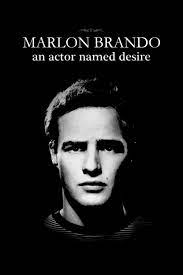
MARLON BRANDO, AN ACTOR NAMED DESIRE
France, 2014, 90 minutes, Colour.
Narrated by Benn Northover.
Directed by Philippe Kohly.
This is very interesting documentary on one of the most celebrated Hollywood stars and film actors of the 20th century. It is a French production, from a director who has made a significant number of documentaries. The voice-over is in English and the various guests on talking heads all speaking in English.
At a basic level, this is a survey of Marlon Brando’s career. It indicates his seemingly random going to acting school, following a young woman in. It shows his training, the influence of Stella Adler and the Actors Studio and Method, Stanislavski, acting. It indicates his early roles but also celebrates the impact he made on stage, taken under the wing of director, Elia Kazan, for A Streetcar Named Desire. It then moves on to his film career, some powerful scenes, especially of anger from the paraplegic veteran, in The Men. There are many sequences from Streetcar illustrating the power of his performance and presence. There are clips from Viva Zapata, again with Elia Kazan.. Much is made of his performance in Julius Caesar as Marc Anthony, working, successfully, with such stars as James Mason and John Gielgud.
The film also shows his influence in moving from Marc Anthony to The Wild One, the image of the leather clad bikie, the influence on James Dean and Elvis Presley. But, a great deal of attention is given to On the Waterfront, especially Brando’s dismay at Kazan’s naming of names to Senator McCarthy and the witchhunt against communists.
Brando’s unreliability is highlighted by his walking out of The Egyptian but Darryl Zannuck suing him and his having to appear as Napoleon in Desiree. This film’s point of view is that this was his succumbing to Hollywood and indicates his unreliability and decline. However, in showing the premiere of Guys and Dolls in New York, it showed how popular he was, within five years of starting his film career – and that this all overwhelmed him.
Unfortunately, for cineastes, there is no mention of any of his films between Guys and Dolls and 1962, Mutiny on the Bounty, omitting his only directing film, One-Eyed Jack’s.
A great deal of attention is given to his misbehaviour and the sabotaging of Mutiny on the Bounty. There is another gap until The Godfather, referring to a number of films he made in the mid-to-late 1960s as “turkeys”. This is unfortunate since there were quality films and the Turkey appellation applies mainly to the fact that they did not succeed at the box office.
The film goes through the background of his audition, a screen test, Francis Ford Coppola wanting him to be Don Corleone a. There is also an emphasis on his refusal to come to the Oscars and seeming sending the young Native American woman to receive the Oscar. There follows the significance of Last Tango, interviews with Bernardo Bertolucci, sequences, and the indication that so much of the portrait was Brando self-revelation.
Attention is also given to the amount of money paid for him to appear in Superman: the Movie, comments by director, Richard Donner, and the difficulties with Apocalypse now , holding up production because he wanted to discuss his character with Coppola, being persuaded to continue by Vittorio Storaro, the cinematographer, who suggested he be filmed in semi-darkness.
He did not make films during the 1980s because of the court cases concerning his son in the murder accusation. There are some brief mention of further appearances, mainly for money.
Of great interest is the documentary on the psychological dimension. The narrative is quite psychoanalytic. Growing up in Nebraska, absent father, both parents alcoholic, a dependence on his mother but a lifelong feeling that she had betrayed her, reliance on his sisters, moving away to New York, a meandering existence, discovering acting (and perhaps making up for the career of his actress mother). The narrative emphasises his angers and how they erupted in performance as seen in the films of the 1950s.
There is also his womanising, numerous affairs, seduction, disappearance, reappearance. There is the strangeness of his marriage to Anna Kafshi, the birth of his son Christian, issues of custody. There is retreat to Tahiti, his relationships, two more children.
Director, Elia Kazan, narrates a great deal about Brando’s early career on stage and screen, insight into his character. There is also his friend, George Englund, with some frank comments about his friend as does Sonia Lee, a long-time friend. From performance point of view, there are comments by Robert Duvall who appeared with Brando in The Chase and The Godfather. Duval has great admiration, mimics Brando on set and his mumbling, but also mentions his elitist attitudes and narcissism. And Ellie Adler, Stella Adler’s daughter, remarks that he was lazy. As the documentary proceeds, Brando appears more and more as a self-centred person, lazy but controlling, acting on whims, and, to that extent, self-destructive, and a haughty attitude in belittling the film industry and acting.
The murder charge against his son Christian and Brando’s appearance in court (the voice-over wondering whether he was performing or genuine) and the impact of his daughter killing herself had a powerful influence on his life during the 1980s when he certainly put on a great deal of weight (and, joked about this on television).
The film ends with a very telling image, from one of the “turkeys” of the 1960s, Reflections on a Golden Eye, some minutes as Brando’s character looks into a mirror, the camera photographing the mirror, a whole range of facial poses, smiling, self-satisfaction. Quite a telling ending to this intriguing documentary.